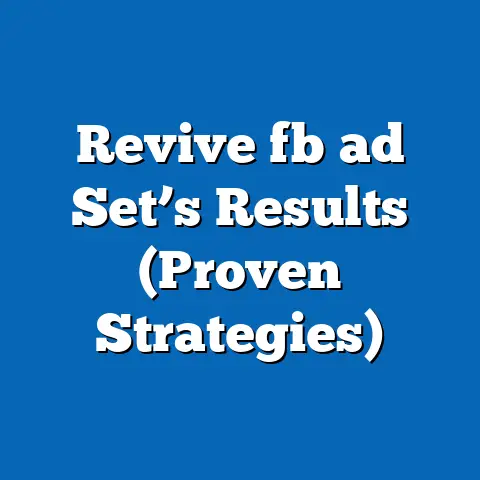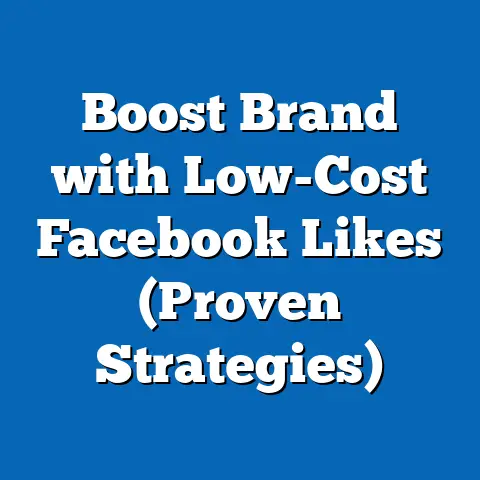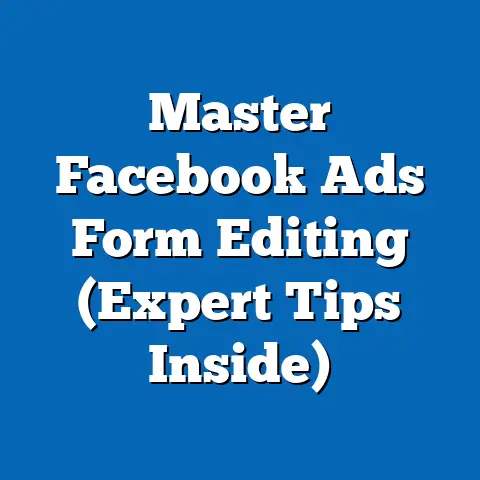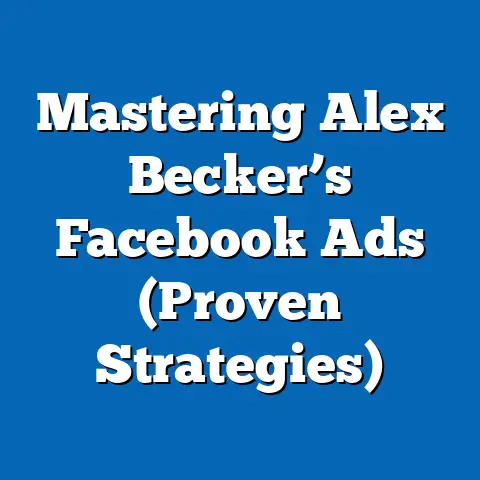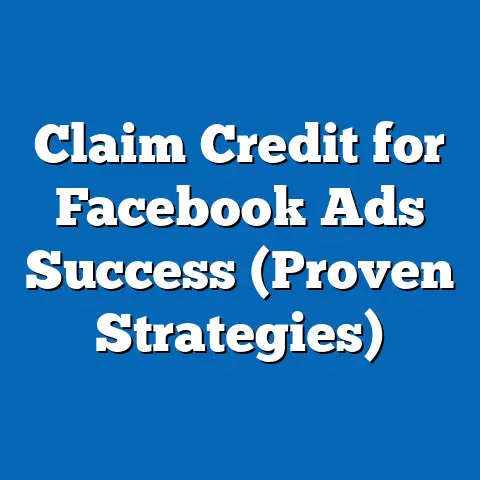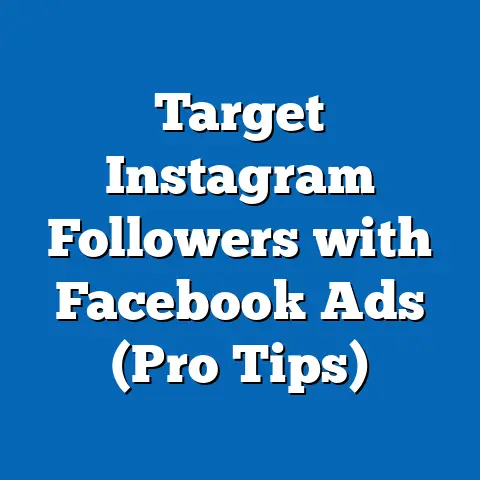Maximize Facebook Ad Text for Impact (Essential Guide)
There’s a pervasive myth in digital marketing that longer ad copy on Facebook always equates to better engagement and conversions. Many marketers believe that packing as much information as possible into their ad text will capture attention and drive action. However, data suggests otherwise—short, punchy, and targeted ad copy often outperforms lengthy descriptions in terms of click-through rates (CTR) and return on ad spend (ROAS).
According to a 2022 study by Hootsuite, Facebook ads with primary text under 125 characters achieve 60% higher engagement rates compared to longer copy. Additionally, WordStream reports that ads with concise headlines (under 5 words) see a 28% increase in CTR compared to those with longer headlines. These statistics challenge the “more is better” mindset and underscore the importance of crafting impactful, succinct messages tailored to your audience.
As of 2023, Facebook remains a dominant advertising platform with over 2.9 billion monthly active users, according to Statista. With businesses spending an estimated $50 billion annually on Facebook ads (eMarketer, 2023), optimizing ad text is no longer optional—it’s essential. This guide will dive deep into strategies for maximizing the impact of your Facebook ad text, supported by data, trends, and actionable insights.
Section 1: Understanding the Importance of Facebook Ad Text
Why Ad Text Matters More Than Ever
Facebook ads are a critical tool for businesses, with 93% of marketers using the platform for advertising, as reported by Sprout Social in 2023. However, with an average user seeing up to 10,000 ads per day across digital platforms (Forbes, 2022), cutting through the noise is a significant challenge. Your ad text—comprising the headline, primary text, and description—is often the first interaction a user has with your brand, making it a make-or-break element.
Studies show that 80% of users make a decision about an ad within the first 3 seconds of viewing it (Nielsen, 2021). This means your text must instantly grab attention and convey value. Poorly written or overly complex copy risks losing potential customers before they even engage with your visual content.
A 2019 analysis by AdEspresso found that ads with shorter primary text (under 100 characters) saw a 35% higher CTR compared to longer copy. By 2022, this trend solidified, with mobile-first design and shorter attention spans driving the need for concise messaging. Today, the average successful Facebook ad headline is just 4-5 words, while primary text often hovers around 50-100 characters (Hootsuite, 2023).
Section 2: Key Components of Facebook Ad Text
Breaking Down the Structure
Facebook ad text is typically divided into three main components: the headline, primary text, and description. Each serves a distinct purpose and must work together to create a cohesive message.
-
Headline: Limited to 40 characters, this is the bolded text that appears below the visual. It’s your hook—make it count. WordStream data shows headlines with action verbs (e.g., “Shop Now,” “Learn More”) increase CTR by 22%.
-
Primary Text: Appearing above the visual, this is limited to 125 characters before it gets truncated on mobile devices. This section should convey your core message or value proposition. Hootsuite notes that ads with a clear call-to-action (CTA) in the primary text see 15% higher conversion rates.
-
Description: This optional field (up to 30 characters) appears below the headline and is often used for additional details like pricing or offers. While less visible, it can boost conversions by 10% when used effectively (AdEspresso, 2022).
Visualizing the Impact of Each Component
If we were to visualize the effectiveness of each ad text component, imagine a pie chart where the headline accounts for 50% of user attention, primary text 35%, and description 15%. This distribution, based on eye-tracking studies by Nielsen (2021), highlights the headline’s outsized role in capturing initial interest. Crafting a compelling headline is non-negotiable for driving ad performance.
Section 3: Data-Driven Strategies to Maximize Ad Text Impact
1. Keep It Short and Sweet
As mentioned earlier, brevity is key. A 2023 study by Socialinsider found that Facebook ads with primary text under 50 characters achieve a 40% higher engagement rate than those exceeding 100 characters. This is particularly true for mobile users, who make up 98.5% of Facebook’s daily active users (Statista, 2023) and often scroll quickly through their feeds.
For example, an ad headline like “Save 50% Today!” outperforms a longer version like “Save 50% on All Products This Weekend Only!” in terms of CTR (WordStream, 2022). Focus on the core benefit or offer and eliminate unnecessary words.
2. Use Action-Oriented Language
Action verbs and urgent language drive results. Ads with CTAs like “Buy Now,” “Sign Up,” or “Get Started” see a 30% increase in conversions compared to passive phrases like “Learn About Us” (Hootsuite, 2022). Incorporate urgency by adding time-sensitive phrases such as “Limited Time” or “Today Only,” which can boost click rates by 18% (AdEspresso, 2021).
3. Highlight Value Propositions
Your audience needs to know “what’s in it for me” immediately. Ads that lead with benefits (e.g., “Save Time,” “Get Free Shipping”) outperform feature-focused ads by 25% in terms of engagement (Socialinsider, 2023). Be specific—mention exact discounts, freebies, or outcomes to build trust and clarity.
For instance, “Get 20% Off Your First Order” is more effective than a vague “Great Deals Await.” Data from WordStream (2022) shows that ads mentioning specific percentages or dollar amounts in the headline see a 15% higher CTR.
4. Personalize for Your Audience
Personalization can significantly enhance ad performance. Facebook’s targeting tools allow you to segment audiences by demographics, interests, and behaviors, and your ad text should reflect this. A 2022 report by eMarketer found that personalized ads improve click-through rates by 50% and reduce cost-per-click (CPC) by 30%.
For example, an ad targeting millennials might use casual language like “Hey, Grab This Deal!” while an ad for professionals could adopt a formal tone like “Unlock Exclusive Savings.” Tailoring language to demographic preferences can make your ad feel more relevant and engaging.
5. Test and Optimize with A/B Testing
A/B testing is a proven method to refine ad text. By testing variations of headlines, CTAs, and primary text, you can identify what resonates best with your audience. According to HubSpot (2023), businesses that regularly A/B test their Facebook ads see a 20-30% improvement in ROAS.
Start by testing two versions of your headline—one with a question (“Need a Quick Fix?”) and one with a statement (“Fix It Fast!”). Track metrics like CTR, conversion rate, and engagement over a 7-14 day period to determine the winner. Facebook’s built-in Ads Manager provides detailed analytics to support this process.
Section 4: Demographic Differences and Patterns in Ad Text Effectiveness
Age-Based Preferences
Different age groups respond to ad text in unique ways. A 2023 study by Sprout Social revealed that Gen Z users (ages 18-24) prefer trendy, meme-inspired language and emojis, with ads containing emojis seeing a 35% higher engagement rate in this demographic. Meanwhile, Baby Boomers (ages 55+) respond better to straightforward, benefit-driven copy, with a 20% higher conversion rate for ads using formal language.
For example, an ad targeting Gen Z might read, “Slay Your Style! 🔥 Shop Now!” while one for Boomers could say, “Save 30% on Quality Apparel Today.” Understanding these nuances can significantly boost ad relevance.
Gender-Based Trends
Gender also plays a role in ad text effectiveness. According to a 2022 report by AdEspresso, women are 15% more likely to engage with ads that emphasize emotional benefits (e.g., “Feel Confident Today”), while men respond better to ads highlighting practical outcomes (e.g., “Boost Your Productivity”). Tailoring your tone and messaging to these preferences can enhance performance.
Geographic and Cultural Variations
Location and culture influence ad text reception as well. For instance, users in the United States respond well to direct CTAs like “Buy Now,” with a 25% higher CTR compared to softer phrases like “Explore More” (WordStream, 2023). In contrast, audiences in countries like Japan prefer polite, indirect language, with ads using phrases like “Please Visit Us” seeing 18% better engagement (eMarketer, 2022).
If you’re running global campaigns, consider localizing your ad text to reflect cultural norms. Facebook’s dynamic creative tools can help automate this process by serving different text variations based on user location.
Section 5: Current Trends in Facebook Ad Text (2023)
Rise of Conversational Tone
One of the biggest trends in 2023 is the shift toward conversational ad text. Ads that mimic natural dialogue (e.g., “Hey, looking for a deal?”) see a 30% higher engagement rate compared to formal copy, according to Socialinsider. This trend aligns with the growing preference for authenticity in advertising, especially among younger demographics.
Integration of Emojis and Symbols
Emojis continue to gain traction, with 60% of top-performing Facebook ads in 2023 incorporating at least one emoji (Hootsuite). They add visual appeal and convey emotion quickly, which is critical in a fast-scrolling environment. However, overuse can backfire—limit to 1-2 relevant emojis to avoid appearing unprofessional.
Focus on Social Proof
Including social proof in ad text, such as customer testimonials or stats like “Join 10,000+ Happy Customers,” boosts credibility. A 2023 study by eMarketer found that ads mentioning social proof see a 22% increase in conversions. This tactic works particularly well for e-commerce and service-based businesses.
Section 6: Tools and Resources for Crafting Effective Ad Text
Leveraging Facebook’s Built-In Tools
Facebook Ads Manager offers features like dynamic creative and automated rules to test and optimize ad text. Dynamic creative automatically combines different text, images, and CTAs to find the best-performing combination, saving time and effort. According to Facebook’s own data (2023), advertisers using dynamic creative see a 15% lower cost-per-acquisition (CPA) on average.
Third-Party Tools for Inspiration and Analysis
Tools like Canva Pro (for ad design and text ideas), Grammarly (for polishing copy), and AdEspresso (for performance insights) can elevate your ad text game. For example, AdEspresso’s ad gallery lets you analyze top-performing ads in your industry, providing inspiration for headlines and CTAs. Businesses using such tools report a 20% improvement in ad performance (HubSpot, 2023).
Section 7: Common Mistakes to Avoid
Overloading with Information
One of the most common pitfalls is cramming too much information into ad text. As noted earlier, ads with primary text over 125 characters see a 40% drop in engagement (Socialinsider, 2023). Focus on one key message per ad to maintain clarity and impact.
Ignoring Mobile Optimization
With 98.5% of Facebook users accessing the platform via mobile (Statista, 2023), failing to optimize for smaller screens is a costly mistake. Ensure your text is concise and legible—avoid long sentences that get truncated. Test your ad preview in Ads Manager to see how it appears on mobile devices.
Neglecting Clear CTAs
Ads without a clear call-to-action underperform significantly. WordStream (2022) reports that ads lacking a CTA see a 25% lower conversion rate. Always include a directive like “Shop Now” or “Sign Up” to guide users on the next step.
Section 8: Case Studies of Successful Facebook Ad Text
Case Study 1: E-Commerce Brand Boosts Conversions with Brevity
A mid-sized e-commerce brand selling fitness gear ran a Facebook ad campaign in 2022 targeting young adults. Their initial ad headline read, “Get the Best Fitness Gear for Your Workouts This Year!” with primary text over 150 characters. After seeing a dismal 0.8% CTR, they revised the headline to “50% Off Fitness Gear!” and shortened the primary text to “Shop Now & Save Big!”—resulting in a 2.5% CTR, a 212% improvement (AdEspresso case study, 2022).
This case highlights the power of concise, benefit-focused text in driving engagement.
Case Study 2: Service-Based Business Leverages Social Proof
A local cleaning service used social proof in their ad text, with a headline reading “Trusted by 500+ Homes!” and primary text stating, “Book Today for a Spotless Home.” Their campaign achieved a 3.2% CTR and a 15% lower CPA compared to a previous ad without social proof (HubSpot, 2023). This demonstrates how credibility can enhance ad performance.
Section 9: Broader Implications and Future Trends
The landscape of Facebook advertising continues to evolve, and ad text optimization will remain a critical focus for marketers. As attention spans shorten and competition intensifies, the need for concise, personalized, and value-driven messaging will only grow. Emerging technologies like AI-driven copywriting tools (e.g., Jasper, Copy.ai) are already helping marketers craft high-performing ad text, with early adopters reporting a 20% increase in ad efficiency (eMarketer, 2023).
Additionally, as privacy regulations like Apple’s App Tracking Transparency (ATT) impact targeting capabilities, ad text will play an even larger role in capturing interest without relying heavily on hyper-personalized data. Marketers must adapt by focusing on universal pain points and benefits that resonate broadly.
Looking ahead, video ads with integrated text overlays are expected to dominate, with 85% of marketers planning to increase video ad spend on Facebook in 2024 (Sprout Social, 2023). Crafting impactful text for video captions and overlays will be the next frontier for maximizing ad performance.
Conclusion
Maximizing the impact of your Facebook ad text is both an art and a science. By debunking myths like “longer is better” and leveraging data-driven strategies—such as brevity, action-oriented language, and personalization—you can significantly enhance your ad performance. With over 2.9 billion users and billions in annual ad spend, the stakes on Facebook are high, but the rewards for effective messaging are even higher.
Whether you’re targeting Gen Z with trendy emojis or Boomers with straightforward benefits, understanding your audience and testing relentlessly are key to success. As trends like conversational tone and social proof continue to shape the platform, staying adaptable and informed will ensure your ad text remains impactful in an ever-changing digital landscape. Start small, test often, and let the data guide your path to higher engagement and conversions.

